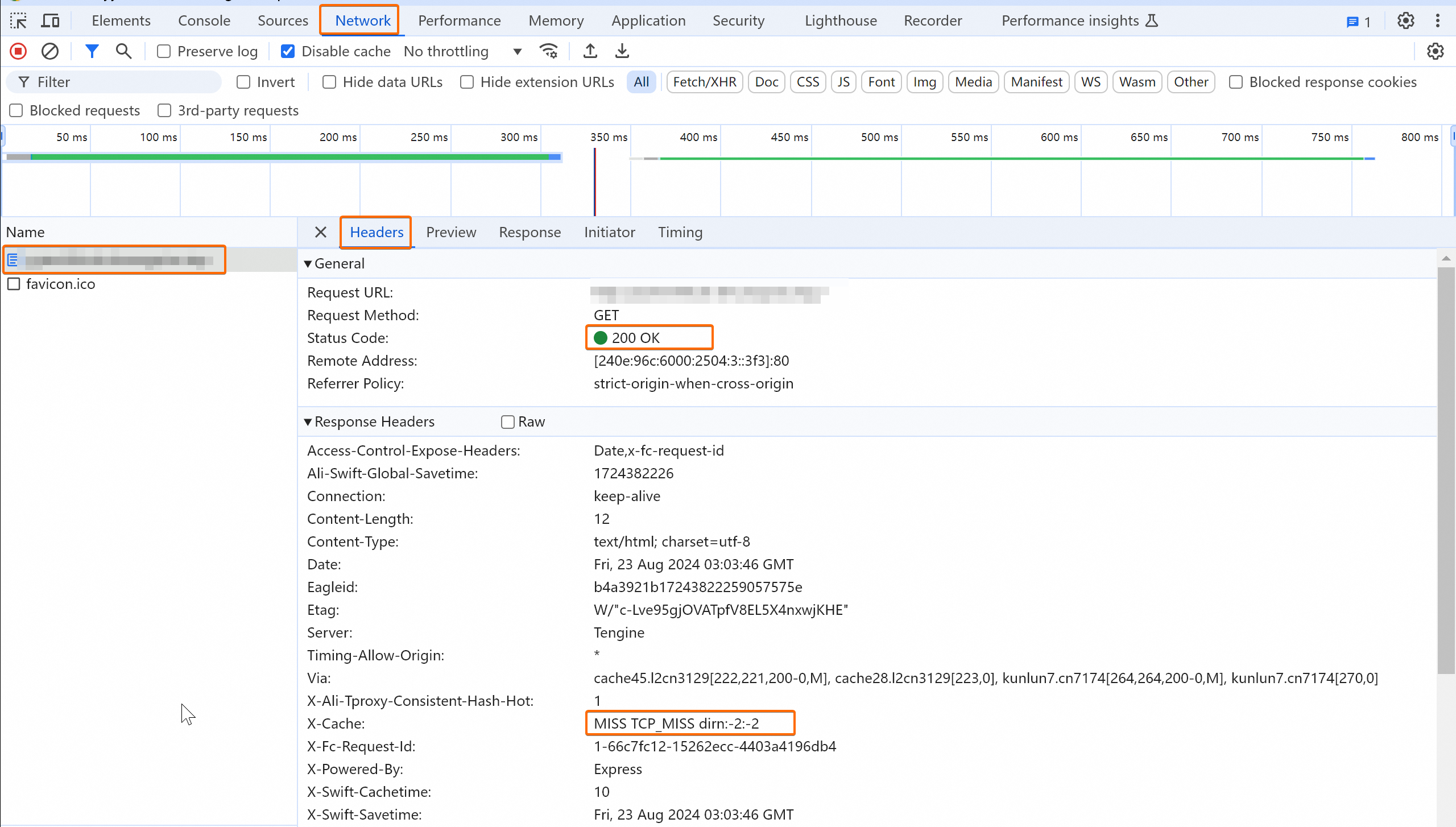If you want to use a fixed domain name to access a Function Compute application or function in a production environment, or prevent forced downloads when you access an HTTP trigger, you can bind a custom domain name to the application or function.
Scenarios
The following items list the typical scenarios in which you need to bind a custom domain name to a function or an application:
You have created a web application and migrated the web application to Function Compute, and want users to access the web application by using a fixed domain name.
You have built a web application in the Function Compute console and want to use different paths of a domain name to trigger different functions.
You have created an application, such as a Stable Diffusion application, in the Serverless Application Center of Function Compute and want to access the application by using a fixed domain name.
Limits
When you bind a custom domain name to a function, you must select the region where the function resides.
The configured custom domain name is case-sensitive. Use the actual domain name for which an Internet Content Provider (ICP) filing is obtained.
You can configure wildcard domain names and standard domain names. You cannot configure domain names that contain Chinese characters.
How it works

Before you begin
Create a function or application. For more information, see Function creation and the "Create an application" section of the Manage applications topic.
To bind a custom domain name to an application is to bind the custom domain name to the functions created by the application. You can find the function resources that are automatically created when the application is created in the Resource Information section of the Environment Details page of the application and click a function name to go to the function details page.

Prepare a custom domain name whose ICP filing information includes Alibaba Cloud as a service provider.
Apply for an ICP filing for the domain name based on the service provider and account to which the domain name belongs. The operations vary based on how the domain name is registered.
Domain names registered by the current Alibaba Cloud account
Apply for an ICP filing for a custom domain name in the Alibaba Cloud ICP Filing system. For more information, see ICP filing process.
Domain names registered by other Alibaba Cloud accounts
Use the Alibaba Cloud account that was used to register the domain name to obtain the ICP filing for the domain name. Apply for an ICP filing for a custom domain name in the Alibaba Cloud ICP Filing system. For more information, see ICP filing process.
Domain names registered by non-Alibaba Cloud accounts
If your domain name is filed through another service provider, you must add Alibaba Cloud to the ICP filing information as a service provider. Log on to the Alibaba Cloud ICP Filing system to apply for an ICP filing for the custom domain name.
NoteYou do not need to apply for an ICP filing for custom domain names that are bound to functions in China (Hong Kong) or regions outside China.
You can query the registrar of a domain name at WHOIS.
You can check whether a domain name belongs to the current Alibaba Cloud account in the Alibaba Cloud DNS (DNS) console.
1. Add a custom domain name
Log on to the Function Compute console. In the left-side navigation pane, choose . On the page that appears, select a region and click Add Custom Domain Name.
ImportantYou can bind a custom domain name only to a function that belongs to the same region as the custom domain name.
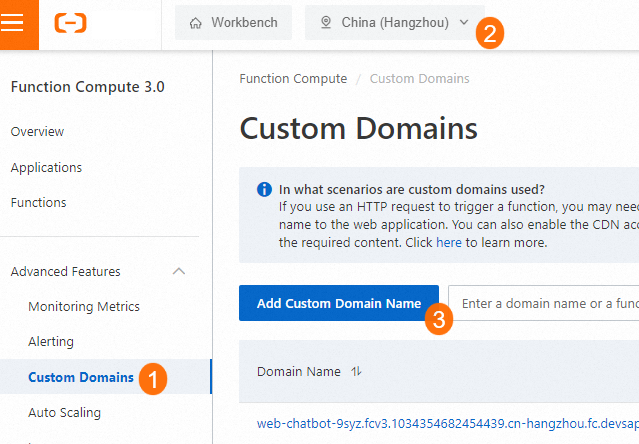
Enter the custom domain name that has obtained an ICP filing in the Alibaba Cloud ICP Filing system or whose ICP filing information includes Alibaba Cloud as a service provider. Single domain names, such as
www.aliyun.com, and wildcard domain names, such as*.aliyun.com, are supported.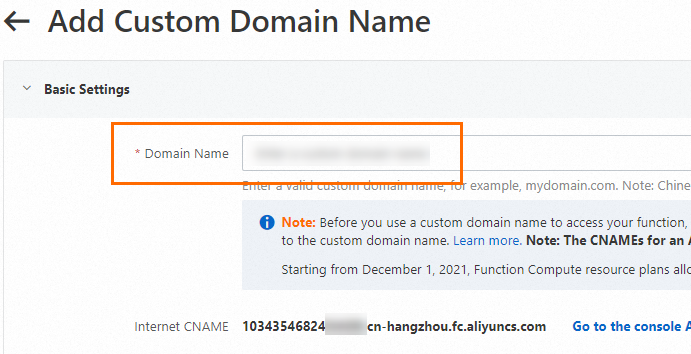
In the Add Custom Domain Name panel, obtain the Internet CNAME or Internal CNAME record. The following table describes the format of a CNAME record.
CNAME type
Format
Example
Internet CNAME
<account_id>.<region_id>.fc.aliyuncs.comIf the ID of your Alibaba Cloud account is 1413397765**** and the function or application resides in the China (Hangzhou) region,
the Internet CNAME is
1413397765****.cn-hangzhou.fc.aliyuncs.com.Internal CNAME
<account_id>.<region_id>-internal.fc.aliyuncs.comthe internal CNAME is
1413397765****.cn-hangzhou-internal.fc.aliyuncs.com.
2. Configure domain name resolution
Log on to the DNS console and resolve the filed domain name to the CNAME of Function Compute. For more information, see Quick Start.
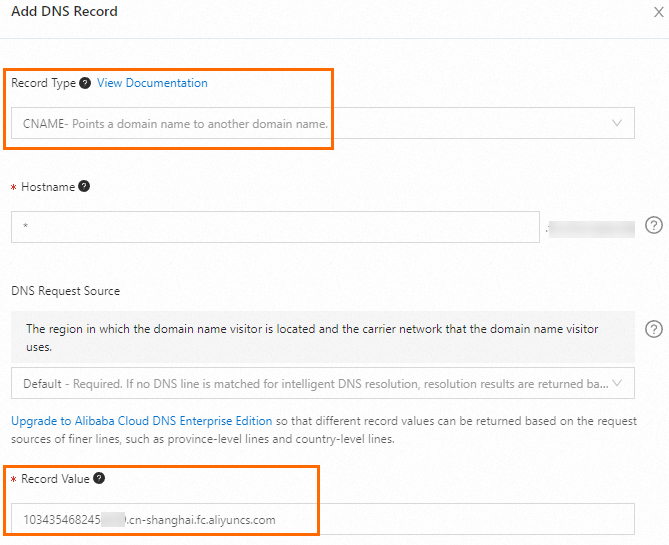
As shown in the preceding figure, you must set Record Value to the CNAME of Function Compute obtained in the previous step. If you want to access the domain name over the Internet, you must set Record Value to the Internet CNAME of Function Compute.
3. Continue to add the custom domain name
Go back to the Add Custom Domain Name page in step 1, configure the following parameters, and then click Create.
3.1 Routing Settings
If your application contains multiple functions, you can configure the mapping between the paths and the functions. Different request paths can trigger different functions. For more information, see the Route matching rules section of this topic.
If you want to rewrite the URI of a request that matches a specified path based on rules, see Configure a rewrite policy (public review).

3.2 (Optional) HTTPS Settings
To enable HTTPS access to a custom domain name, configure the following parameters.

Parameter | Description |
HTTPS | Specify whether to enable HTTPS. After you enable HTTPS, the custom domain name can be accessed over HTTP and HTTPS. If you disable HTTPS, the custom domain name can be accessed only over HTTP. Note You can also select the Redirects HTTP Requests to HTTPS check box to allow only HTTPS requests to access the custom domain name. Function Compute redirects requests that are accessed over HTTP to HTTPS. |
Certificate Type | The type of the certificate that you want to upload. Valid values:
Note The certificate that you want to upload cannot exceed 20 KB in size. The certificate key cannot exceed 4 KB in size. |
TLS Version | The transport layer security (TLS) protocol version that the function uses. Note After you select a TLS version, you can also select Enable Support for TLS1.3 to enable TLS 1.3. |
Cipher Suite | The TLS cipher algorithm suites. If you leave this parameter empty, all cipher suites are selected. Valid values:
Important
|
3.3 (Optional) Authentication Settings
No Authentication: No authentication is required for HTTP requests, and anonymous access is supported. Anyone can initiate HTTP requests to invoke your function.
Signature Verification: Signature authentication is required on HTTP requests. For more information, see Configure signature authentication for custom domain names.
JWT Authentication: JWT authentication is required on HTTP requests. For more information, see Configure JWT authentication for custom domain names.

3.4 (Optional) WAF Settings
WAF identifies malicious traffic in functions and applications, scrubs and filters out malicious traffic, and returns normal traffic to backend functions to protect your functions against malicious intrusions. For more information, see Enable WAF protection.

3.5 (Optional) CDN Settings
After you bind a custom domain name to a web application, you can use the custom domain name as the origin domain name and add an accelerated domain name to it. Then, you can configure a CNAME for the accelerated domain name. This way, CDN acceleration is enabled for the custom domain name. The application that is deployed in Function Compute serves as an origin server, and the source content is published to edge nodes. This way, end users can read data with high efficiency. This efficiently reduces the latency and improves service quality.
Set CDN Acceleration to Enable. Specify a custom CDN-Accelerated Domain Name and click Create.
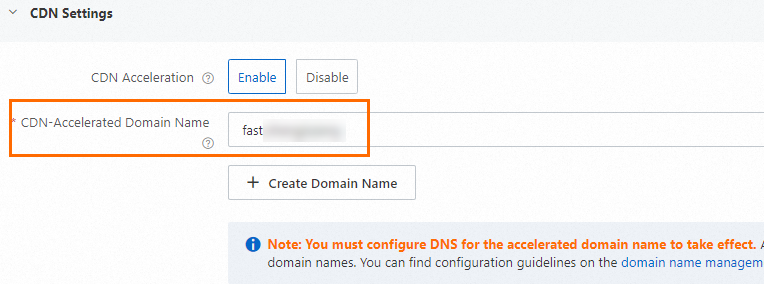 Important
ImportantIf you enable CDN acceleration, you are charged for Internet traffic. For more information, see Billing overview.
The custom domain name and the accelerated domain name cannot be the same. To save domain name resources, you can set CDN-Accelerated Domain Name to the second-level domain name (the subdomain name) of your custom domain name. For example, if you set the custom domain name to
example.com, you can set CDN-Accelerated Domain Name tofast.example.com.
Click the custom domain name that you configured. In the CDN Acceleration Settings section of the custom domain name details page, click CDN Settings in the Actions column to go to the Alibaba Cloud CDN console and obtain the CNAME that is assigned to the CDN-accelerated domain name by Alibaba Cloud CDN.


The preceding figure shows an example. A CNAME follows the
Accelerated domain name.w.kunlun**.comformat. Example:fast.example.com.w.kunlunle.com.Log on to the DNS console, find your custom domain name, and then point the Domain Name System (DNS) record of the domain name to the assigned CNAME to implement acceleration. For more information, see Quick Start.
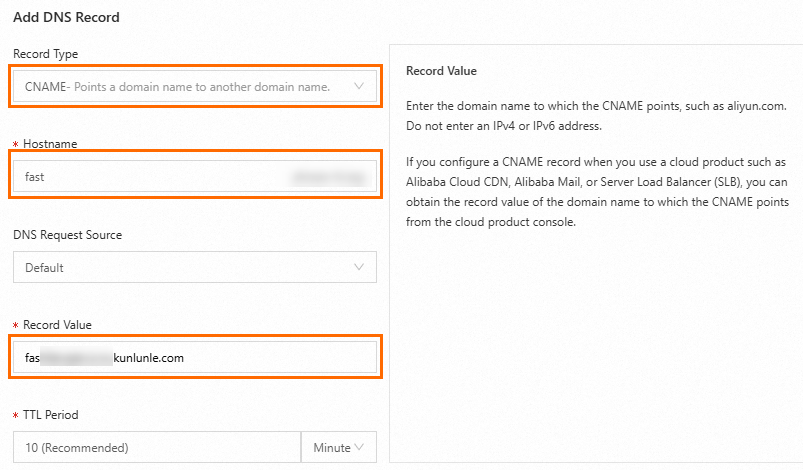
The preceding figure shows an example. Set Hostname to the first level of the accelerated domain name. In this example, the value is
fast. Set Record Value to the accelerated domain name that you configure in the previous step.
4. Verify the custom domain name
4.1 Verify whether the custom domain name can be accessed
Method 1: Run the
curl URLcommand, Example:curl example.com/login.Method 2: Use a browser.
Enter the request URL in the address bar of a browser and press the Enter key to check whether the specified function is invoked.
4.2 (Optional) Verify the accelerated domain name
Use the CDN-accelerated domain name that you configured in 3.5 (Optional) CDN Settings in the browser to access the application. Then, open a developer tool and check the return value of the X-Cache field in the response to determine whether the accelerated domain name takes effect.
The return value of the X-Cache field indicates the actual effect of the CDN cache policy. "MISS" in the value indicates that the first access to the CDN point of presence (POPs) misses and resources need to be requested from the origin server. If the missing resource is retrieved from the origin server, the resource is cached on the POP. The value of the X-Cache field in subsequent requests for the resource starts with HIT, which indicates that the requested resource has been cached on and served from the POP.
First access misses | Subsequent accesses hit |
|
|
Cipher suites
Strong and weak cipher suites
Mapping between TLS versions and cipher suites
Mappings between RFC cipher suite names and OpenSSL cipher suite names
Matching rule
Route matching rule
You must configure the mapping between paths and functions when you bind a custom domain name. This way, requests from different paths can trigger different functions. Function Compute supports exact matching and fuzzy matching for paths. The following items describe the matching rules:
Exact matching: A function is triggered only if the path of the request is exactly the same as the specified path.
For example, you have created a route whose path is /a, the corresponding function is f1, and the corresponding version is 1. In this case, only requests from the /a path can trigger Function 1 of Version 1.
Fuzzy matching: You can append an asterisk (*) as a wildcard to a path.
For example, you have created a route whose path is /login/*, the corresponding function is f2, and the corresponding version is 1. Requests from paths that begin with /login/, such as /login/a and /login/b/c/d, can trigger Function 2 of Version 1.
If multiple routes are configured for a custom domain name, exact matching takes precedence over fuzzy matching.
The longest prefix match (LPM) rule applies when fuzzy matching is performed.
For example, the /login/a/* path and the /login/* path are configured for the custom domain name
example.com, and the request URL is example.com/login/a/b. The request URL matches the configured paths. However, the /login/a/* path is used based on the longest prefix match (LPM) rule.
Example
For example, the custom domain name is example.com and five routing rules are configured based on the steps described in this topic. The following table lists the routing rules.
Routing rule | Path | Function | Version |
Routing rule 1 | / | f1 | 1 |
Routing rule 2 | /* | f2 | 2 |
Routing rule 3 | /login | f3 | 3 |
Routing rule 4 | /login/a | f4 | 4 |
Routing rule 5 | /login/* | f5 | 5 |
The following table describes the final matches.
Request URL | Matched function | Matched version | Matched path |
example.com | f1 | 1 | / |
example.com/user | f2 | 2 | /* |
example.com/login | f3 | 3 | /login |
example.com/login/a | f4 | 4 | /login/a |
example.com/login/a/b | f5 | 5 | /login/* |
example.com/login/b | f5 | 5 | /login/* |
Domain name matching rule
Function Compute matches a domain name based on the domain name information in your request and forwards the request to the function that corresponds to the matched domain name. Function Compute supports exact matching and fuzzy matching for domain names. The following items describe the matching rules:
Exact matching: The function that corresponds to the domain name can be triggered only if the domain name of the request exactly matches the custom domain name that you created.
Fuzzy matching: Wildcard domain names are supported. The function can be triggered if the domain name of the request matches the custom domain name that you created based on wildcards. A maximum of one wildcard character (*) can be contained in a domain name, and the wildcard character must be placed at the beginning of the domain name.
If a request matches a single domain name and a wildcard domain name at the same time, the request is forwarded to the function that corresponds to the single domain name.
In fuzzy matching, a wildcard domain name can match only a domain name at the same level. For example,
*.aliyun.comcan matchfc.aliyun.com, but notcn-hangzhou.fc.aliyun.com.*.aliyun.comandfc.aliyun.comare third-level domains andcn-hangzhou.fc.aliyun.comis a fourth-level domain.
Example
The following table shows the results of request domain names that match the following existing domain names: fc.aliyun.com, *.aliyun.com, and *.fc.aliyun.com.
Request domain name | Matched domain name |
fc.aliyun.com | fc.aliyun.com |
fnf.aliyun.com | *.aliyun.com |
cn-hangzhou.fc.aliyun.com | *.fc.aliyun.com |
accountID.cn-hangzhou.fc.aliyun.com | None |
FAQ
Can a public endpoint of an HTTP trigger be used in a production environment?
What do I do if a 502 Bad Gateway error is reported when I access a custom domain name?
What do I do if errors are reported when I use a Chinese-character domain name to configure a custom domain name?
How do I resolve the issue of forced downloads when I access a domain name through a browser?
What do I do if a 301 redirect occurs when I access an accelerated domain name?
What do I do if I cannot select an existing function when I configure routes?
What do I do if a function cannot be triggered by using a route?
Diagnostics
If an error occurs when you bind a custom domain name, the server returns an error message. The following table describes common error codes to help you quickly identify and resolve issues.
Error code | HTTP status code | Error message | Cause |
InvalidICPLicense | 400 | domain name '%s' has not got ICP license, or the ICP license does not belong to Aliyun | The domain name does not have an ICP filing or the ICP filing information does not include Alibaba Cloud as a service provider. |
DomainNameNotResolved | 400 | domain name '%s' has not been resolved to your FC endpoint, the expected endpoint is '%s' | No CNAME is configured for the domain name to point to the specified endpoint. You can check the CNAME settings by running the dig command or logging on to the DNS server. |
DomainRouteNotFound | 404 | no route found in domain '%s' for path '%s' | No function is configured for the specified path. |
TriggerNotFound | 404 | trigger 'http' does not exist in service '%s' and function '%s' | No HTTP trigger is configured for the function that is bound to the custom domain name. |
DomainNameNotFound | 404 | domain name '%s' does not exist | The domain name that you want to query does not exist. |
DomainNameAlreadyExists | 409 | domain name '%s' already exists | The domain name that you want to bind already exists. |
If the issue persists, join the DingTalk group 64970014484 for technical support.
